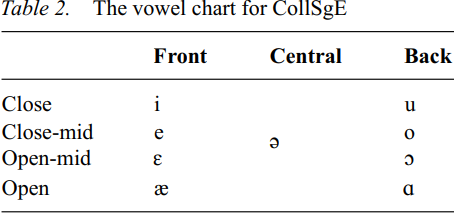


 Grammar
Grammar
 Tenses
Tenses
 Present
Present
 Past
Past
 Future
Future
 Parts Of Speech
Parts Of Speech
 Nouns
Nouns
 Verbs
Verbs
 Adverbs
Adverbs
 Adjectives
Adjectives
 Pronouns
Pronouns
 Pre Position
Pre Position
 Preposition by function
Preposition by function 
 Preposition by construction
Preposition by construction
 Conjunctions
Conjunctions
 Interjections
Interjections
 Grammar Rules
Grammar Rules
 Linguistics
Linguistics
 Semantics
Semantics
 Pragmatics
Pragmatics
 Reading Comprehension
Reading Comprehension|
Read More
Date: 2024-03-20
Date: 2024-03-19
Date: 2024-03-23
|
The following set of keywords illustrates the lexical incidence of the vowels.

(POOR is not part of the standard lexical set, but has been included here because the CollSgE diphthong /uə/ appears in words such as poor, sure and tour.)

The following table provides a summary of the consonant inventory of CollSgE. It has been noted that accents of English do not differ very much in their consonant inventories, and in this respect, the consonant inventory of CollSgE is similar to that of a variety such as RP.

Two points are particularly worth noting. One, there is no aspiration of voiceless plosives or affricates in CollSgE. This means that /p/, for example, is realized the same way in words like pin and spin. Two, the interdental fricatives tend to be realized as [t, d] when pre-vocalic and [f] when at the end of a word. For example, thin is realized as [tin] and then as [den], but in word-final position, we get [brεf] and [brif] for breath and breathe respectively. This gives an alternation between [f] and [t] in filth [filf] and filthy [filti] since in the second word, the consonant is in pre-vocalic position. Words ending in /t/ do not display this alternation, as seen with a pair such as guilt [gilt] and guilty [gilti]. It is this alternation which leads Hung (1995: 32) to tentatively posit the interdental fricatives as CollSgE phonemes even though they are, in fact, never phonetically realized as such:
It is therefore quite possible that there is a separate phoneme in SE (represented in other accents as /θ/) which is distinct from /t/ and /f/, and which is phonetically realized as [t] in the onset and [f] in the coda of a syllable. Obviously, further data and analysis are required before any such conclusion can be drawn.
Hung’s caution is understandable since this, of course, bears on the theoretical question of just how abstract phonological representations ought to be. This is a controversial issue, and perhaps particularly so in the study of new varieties of English since there are often ideological as well as more ‘purely’ linguistic ones for wanting to treat each variety as a self-contained system. Whether this is in fact possible is a matter of some contention.
Where the vowels are concerned, CollSgE contains nine monophthongs and five diphthongs. Table 2 provides a list of the monophthongs. The five CollSgE diphthongs are /ai, ɔi, au, iə, uə/.
Two features of the CollSgE vowels bear mentioning, both relating to the neutralization of vowel distinctions. The first is that there is no length contrast so that any length difference tends to be sporadic. Hung (1995: 29) points out that while Singaporean speakers may be able to detect and even mimic vowel length differences in other varieties of English, "in their own spontaneous, natural speech, no distinction is normally made…". Thus, the distinction found in RP, for example, in pairs like pool/pull or beat/bit is absent in CollSgE; the pairs are essentially homophonous instead. The other is that there is also no contrast between tense and lax vowels so that all vowels tend to be ‘equally tense’. However, given that the tense-lax distinction has been criticized for being too vague, and that tense vowels are more likely to be longer, it might be possible to reduce the two features to one, and simply note the absence of contrastive vowel length in CollSgE.
|
|
|
|
دراسة يابانية لتقليل مخاطر أمراض المواليد منخفضي الوزن
|
|
|
|
|
|
|
اكتشاف أكبر مرجان في العالم قبالة سواحل جزر سليمان
|
|
|
|
|
|
|
اتحاد كليات الطب الملكية البريطانية يشيد بالمستوى العلمي لطلبة جامعة العميد وبيئتها التعليمية
|
|
|